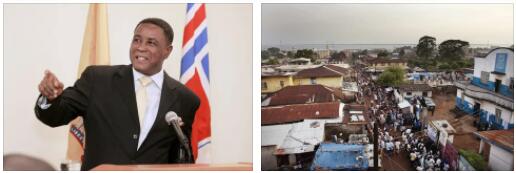State structure and political system of Sierra Leone
Sierra Leone is a republic. On March 29, 1996, the 1991 Constitution, suspended in April 1992, was renewed. Administratively, Sierra Leone is divided into 3 provinces (Eastern, Northern and Southern) and the Western Region (Freetown with suburbs). The largest cities: Freetown, Koidu, Bo, Kenema, Makeni. Check cancermatters for political system of Sierra Leone.
The government of Sierra Leone is carried out by three branches of government: legislative, executive and judicial. The highest body of legislative power is the unicameral parliament. The highest executive authority is the president, who is the head of state and head of government (President Ahmed Tejan Kabbah, since March 29, 1996, overthrown on May 25, 1997, restored to power on March 10, 1998, re-elected on May 14, 2002). Government ministers are appointed by the president and then approved by parliament.
The president is elected by universal suffrage for a term of 5 years (the tenure is limited to two terms). Parliament is also elected for a term of 5 years, and out of 124 deputies, 112 are in general elections and 12 are paramount leaders.
Among the prominent political leaders of Sierra Leone: Siaka Probin Stevens – Prime Minister (1968-71), President (1971-85), creator of a one-party system, initiator of building a social justice society in Sierra Leone based on socialist principles and stimulating a national state and private enterprise.
There is a multi-party system. In addition to the ruling Sierra Leone People’s Party, which has 83 seats, the All People’s Congress party (22 seats) and the Peace and Liberation Party (2 seats) are represented in parliament. The People’s Democratic Party, the National Unity Party, the National Unity Movement, the Center Democratic Party, the Coalition for Progress, the People’s National Convention and a number of other parties also function in the country.
Leading business organizations include the Sierra Leone Employers’ Federation, the Chamber of Commerce, Industry and Agriculture, and the Chamber of Mines. There are trade union organizations united under the auspices of the Labor Congress of Sierra Leone, as well as youth and other organizations in the country.
The armed forces of Sierra Leone have approx. 10 thousand soldiers and officers (2001).
Sierra Leone has diplomatic relations with the Russian Federation (established with the USSR on January 18, 1962).
Economy of Sierra Leone
Sierra Leone is among the ten poorest countries in the world. GDP 2.7 billion US dollars, i.e. OK. $500 per capita (2001). Still in con. 1980s OK. 68% of the population was below the poverty line. GDP growth rate 3% (2001). Inflation 15% (2000).
In the sectoral structure of the economy, agriculture accounts for 43% of GDP (2000), and the vast majority of the economically active population, up to 80%, is employed in agricultural production. The share of industry in GDP is 27%, services 30%.
Agriculture is represented mainly by crop production, producing consumer crops (rice, cassava, millet, sorghum, etc.) for personal consumption. Only a small share of these products enters the domestic commodity market. Commercial crops are also grown – cocoa, coffee, oil palm. Due to the spread of the tsetse fly, animal husbandry is poorly developed. Fishery products in coastal and inland waters are consumed domestically and partially exported.
Industry is underdeveloped. The leading place in its sectoral structure is occupied by the mining of diamonds, rutile, as well as small volumes of bauxite and gold. The manufacturing industry is represented by small enterprises focused on the local market.
The main mode of transport is automobile, the network of roads is 11.7 thousand km, incl. 936 km are paved roads and 10,764 km are unpaved roads (2002). The total length of railways is 84 km with a narrow (1067 mm) gauge (2001).
Seaports in Freetown, Bont and Ashes. The merchant fleet has 55 ships (1997). Navigation is also carried out along the rivers, 600 km of which are open for navigation all year round. There are 10 airfields in the country, incl. only one of them has a paved runway and two helipads (2002).
The country has 9 ultra-shortwave, one medium and one shortwave radio stations, two television stations (1999), 1.12 million radio receivers and 53 thousand television sets are in use (1997), there are 25 thousand telephone lines and 30 thousand people. covered by cellular communications (2001), one Internet provider and 20 thousand Internet users (2001).
There are 5 banks in Sierra Leone, the Bank of Sierra Leone plays the role of the central one. The external debt of Sierra Leone is 1.3 billion US dollars (2000).
State budget (2000, million USD): revenues 96, expenditures 351.
Through foreign trade channels, Sierra Leone receives food, machinery, equipment, fuels, lubricants, chemicals and other goods in exchange for diamonds, rutile, iron ore, cocoa, coffee and seafood.
Science and culture of Sierra Leone
Read and write (in English or in Mende, in dark, in Arabic) are able to 31.4% of adult residents of Sierra Leone, incl. 45.4% male and 18.2% female (1995 est.). The country has a university and 16 colleges (technical and pedagogical).
